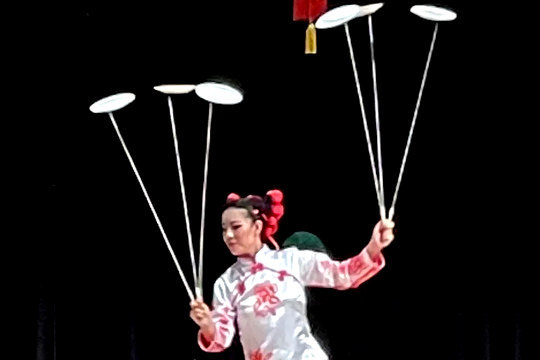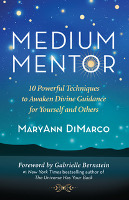
Learning to spin several plates at once.
Spiritual teachers and traditions frequently use the concept of balance to refer to a variety of things. When I write about balance, I’m referring to balancing our physical body, our spiritual body, our mental body, and our emotional body. Together, these form our total being. The goal is to assess the various aspects of our lives and find balance between them, thereby aligning our soul with its greatest potential.
This assessing-and-balancing technique is helpful because it’s the factor that allows us to remain completely connected to Spirit, accessing guidance when we need it throughout our day, while still living in the world. Sure, there are people who feel called to go spend the rest of their lives meditating in a cave, and if you are one of them, I encourage you to follow that guidance.
But for the rest of us — the ones whose lives include taking kids to soccer practice every Tuesday, going to the office on weekdays from 9 to 5, gathering for family reunions, and volunteering at an animal shelter or doing whatever it is that brings us joy that isn’t specifically “psychic activity” — balance is essential. This is even (and perhaps especially) true for those who integrate their intuitive practice into their social and/or professional lives.
I like to think of getting balanced as tending to a large set of spinning plates on the ends of poles, like in a circus act. When someone is out of balance — or, more often than not, when that someone is me — I see one of the plates begin to wobble. Spinning a bunch of plates at once is an active, dynamic process.
Balance isn’t something we achieve one time; we don’t just tick the “get balanced” box off our spiritual to-do list and call it good. Getting balanced means assessing and adjusting on an ongoing basis. It’s a constant motion, a regular negotiation between ourselves and the various aspects of our lives. It’s a learning process. While we’re learning to spin numerous plates at once, it’s a given that some plates are going to drop. That’s part of learning.
A dropped plate isn’t a failure but an inevitability. Our work, then, is to develop the resources to allow us to pick up the plate quickly and get it spinning again. We aren’t responsible for being flawless; instead, it’s up to us to do our best, to try to keep pace with our plates and respond effectively when they fall. Knowing this takes the pressure off. It allows us to focus on the endeavor of trying to keep the plates going without getting attached to perfection.
So what are the plates? In this analogy, the plates represent the different aspects of our lives. This includes the roles we play in relation to other people as well as the way we spend our days — the ideas and activities that engage us as we go through our lives. Work and career usually comprises one plate, parenthood another, romance and partnership another, and so forth.
Our homelife is its own plate, as is our actual home — the environment we have created to spend so much time in. Our relationship to the earth is as well. Our physical body includes its own set of small plates, like exercise, sleep, and nutrition. Friendship and recreation are plates. Quietude and creativity are, too.
How Do We Measure Balance?
Our balance can therefore be measured by the health of our relationship to each of these areas. Note here that I’m not referring to everything going right in each of these areas. I’m not referring to everything being easy or devoid of problems. This is a common misconception about balance: the idea that being in balance means everything goes our way. Instead, as I understand balance, it refers to our ability to attune to and address what we need in any given moment.
When we’re in balance, we feel that we’re right with Spirit. We’re in alignment. We’re tending to what is important to us; we’re creating and maintaining a joyful existence. Our lives may not be perfect — in fact, it’s pretty likely they aren’t! — but our souls are fed. This is how it feels when our beautiful plates are spinning nice and flat, like we have healthy, meaningful relationships with the world around us.
Once we get all our plates spinning, our focus can shift to keeping them that way. It’s important to notice that this is, in essence, an impossible task — that like so many of the other techniques in this book, such as working with ego, fear, and boundaries, balance is an ongoing pursuit. We’re here, we’re learning lessons, and sometimes we’re learning them the hard way. If we can stabilize ourselves enough to find balance, however, we can start to progress more steadily.
We may be able to use our intuition to recognize a little bit sooner that one of our plates is beginning to wobble than we would have in the past — this is a huge victory! We can tap into our intuition, which tells us there is something important in our lives that needs tending and attention. We may even begin to rescue our plates, catching and righting them the second before they fall.
To do this, it helps to understand how and when plates fall. Often the thing that allows one plate to fall is focusing too much on another. We lean in, trying to get one plate spinning just right, not noticing that the plate behind us is terribly out of whack.
It’s also common for us to intentionally look away from a wobbling plate; perhaps realizing that an area of our lives isn’t really working brings us too much anxiety, or maybe we just feel too exhausted to deal with it. We let the plate wobble and wobble, ignoring what’s happened, and we’re not really surprised to see it come crashing down — we just didn’t know what to do about it.
Sometimes, a plate falling can block our spiritual connection — not in a scary, long-term way but in a temporary, hey-wake-up sort of way. This is often actually our own guides trying to get our attention to tell us where and how we need to put in work.
PRACTICE: Finding Your Balance
This practice involves connecting with your guides to see where you’re out of balance.
You’ll do so through automatic writing. I encourage you to make this process your own. I’ve provided suggestions, but if other questions or ideas come to you, the sky is the limit! Many intuitives use automatic writing frequently in their practice, and I urge you to explore your technique, finding the way that works best for you.
There are two things I suggest to everyone:
First, take enough time to do this. We often get the impulse to automatic-write but then start questioning ourselves, which leads us to get only the beginning of the transmission.
Second, to prevent this, keep your pen moving the entire time. Just keep going, even if you think it’s nonsense. Making this a habit will train your brain to not question what you receive. You may shift handwriting, energy, use of language as you go — roll with it. You may even change guides within the same writing. You may know exactly who you are channeling, or you may not (though if you want to channel someone specific, writing the name of a loved one — or of a guide if you know it — at the top of the page can help).
This particular automatic-writing exercise has several steps, and I encourage you to go through them back-to-back, in a single sitting. You’ll need at least twenty minutes to do so. You’ll also want a journal, a pen, and a timer.
Start by writing a specific guide’s name at the top, if appropriate, or you can just generally direct it to all your guides with your intention.
Question 1
First, you’ll identify the areas of your life that are out of balance. Write one of the following questions:
-
Where am I out of balance?
-
What am I missing?
-
How am I out of alignment?
Set a timer for five minutes and freewrite. Keep your pen moving the whole time.
When you finish, read what you wrote aloud. It’s important to hear the words spoken, so please don’t skip this step, even if it feels silly! Reading aloud is a fantastic way to receive guidance on a deeper level.
Look back at what you wrote — which may be anything from a list to beautiful poetry to a scrawling, scribbly mess — and study it for themes, such as family, work, or health. Then, below your automatic writing, clearly list the themes you find.
Question 2
Next, you’ll look at what you’re doing to contribute to the issue. Here, you’ll discover the actions your guides want you to stop doing in order to find balance. Write one of the following questions:
-
What am I doing to contribute to this imbalance?
-
What actions could I avoid in order to address the imbalance in _______ [theme]?
-
What pattern do I need to stop falling into?
Again, set your timer and write for five more minutes. When you finish, look at both your lists. You may notice a negative slant to your answers, such as “Eating processed sugar,” “Staying in my comfort zone,” or “Judging my friends.” It’s often easier for us to think in the negative. There’s nothing inherently wrong with that, but Spirit works in the positive, so we’re best served if we flip these ideas around.
Next to any negative answer, write down its positive, solution-oriented equivalent, such as “Eat more fruit,” “Try new things,” or “Appreciate my friends more.”
Question 3
Now you’ll further consider where you need to start taking action. Write one of the following questions:
-
What do I need to do?
-
What actions could I take to address the imbalance in _______ [theme]?
-
How can I move myself back toward balance?
Set your timer for five minutes and freewrite again. This time, as you download, push for specific details — the more specific, the better. Set the clear intention that you want guidance that involves action.
When you’re finished, read your answers to questions 2 and 3 aloud. Again, please don’t skip this! Then, if your next steps aren’t already quite obvious, distill your download into a set of practical actions you can take or behaviors you could change. Examples include: “Set up a doctor’s appointment,” “Start meditating for ten minutes in the mornings,” “Replace my repetitive thoughts with a mantra,” and “Sign up for a dance class.”
Then, to the degree that it’s possible, commit to each action here and now. For example, get out your phone and schedule the doctor’s appointment, or set an alarm to remind you to meditate. If you need to automatic-write in the mornings, put your journal and a pen next to your bed, or if you need to join a certain class, start looking for one that might suit you.
Be sure to get any important dates and times onto your schedule and to find the funds you might need, reallocating, saving, or fundraising as necessary. I encourage you to not shy away from these logistical details; they’re an essential part of living a balanced life on Earth.
Sustaining a Balanced Life
Finding and maintaining balance between the spiritual, emotional, physical, and mental bodies is crucial if we want our spiritual life to be sustainable long-term. This commitment to balance allows us to remain deeply connected to the realm of Spirit while keeping our feet firmly planted on the physical plane. It helps us become portals of the light, bringing Source energy right here and spreading it around the world. This is our most sacred mission as intuitives.
Beyond that, the details of the mission vary from person to person. Each of us is accountable for finding our own way to share the light we receive. Whether it’s as a psychic medium, a healer, a teacher, a parent, an animal communicator, or anything else, the role of bringing the divine light to Earth is a sacred business. It’s up to us to find our own unique service.
Copyright 2022 by MaryAnn DiMarco. All Rights Reserved.
Printed with permission from the publisher, New World Library.
Article Source:
BOOK: Medium Mentor
Medium Mentor: 10 Powerful Techniques to Awaken Divine Guidance for Yourself and Others
by MaryAnn DiMarco
 Written by an experienced psychic medium and teacher, Medium Mentor will guide you to connect more deeply to your soul’s innate abilities and employ them to enhance your everyday life and serve others. Through true stories and expert tips, MaryAnn DiMarco reveals the magic, joy, and responsibility of developing psychic gifts and working with souls on the Other Side, as well as how to interpret the powerful energy you experience and establish boundaries.
Written by an experienced psychic medium and teacher, Medium Mentor will guide you to connect more deeply to your soul’s innate abilities and employ them to enhance your everyday life and serve others. Through true stories and expert tips, MaryAnn DiMarco reveals the magic, joy, and responsibility of developing psychic gifts and working with souls on the Other Side, as well as how to interpret the powerful energy you experience and establish boundaries.
MaryAnn’s deep wisdom comes through as she teaches you to create your own unique approach to intuition and understand and implement universal guidance.
For more info and/or to order this book, click here. Also available as a Kindle edition.
About the Author
 MaryAnn DiMarco is an internationally recognized psychic medium, healer, and spiritual teacher, her work has been featured in media outlets like The New York Times, The Dr. Oz Show, Women’s Health, Elle, and Redbook.
MaryAnn DiMarco is an internationally recognized psychic medium, healer, and spiritual teacher, her work has been featured in media outlets like The New York Times, The Dr. Oz Show, Women’s Health, Elle, and Redbook.
Visit her online at MaryAnnDiMarco.com.



























